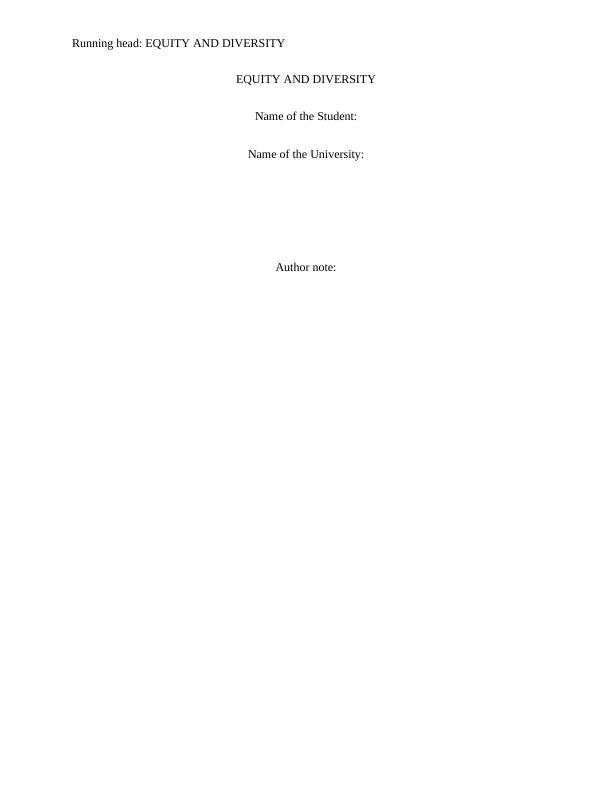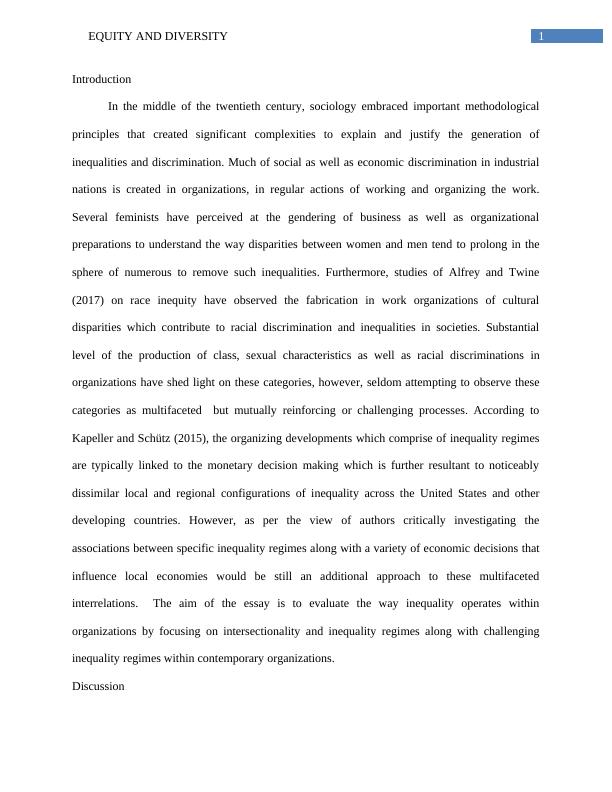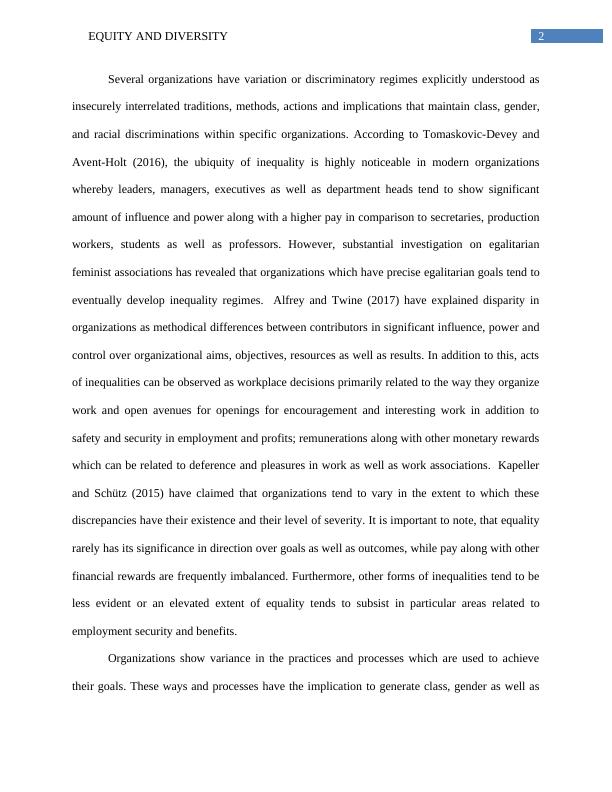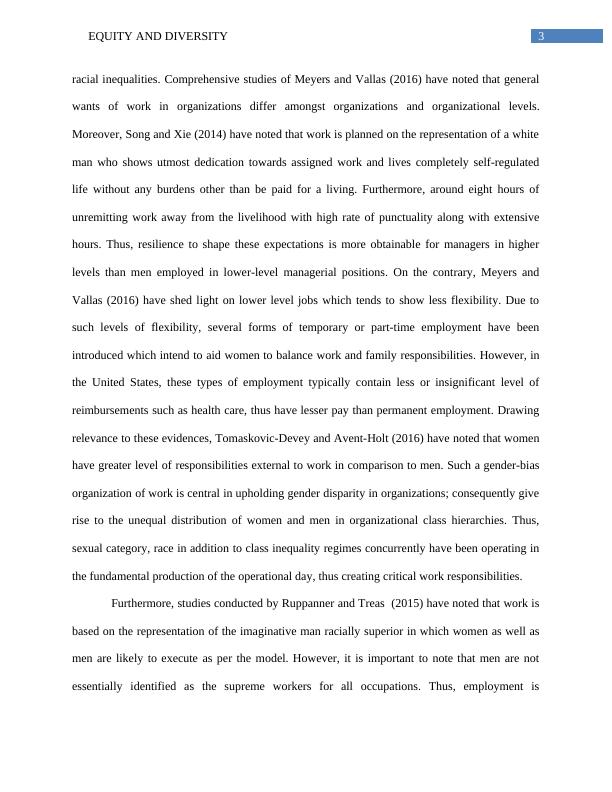Equity and Diversity in Organizations
13 Pages3668 Words65 Views
Added on 2023-03-20
About This Document
This essay discusses the concept of equity and diversity in organizations, with a focus on intersectionality and inequality regimes. It explores how inequalities are created and sustained within organizations, and the impact of gender, race, and class on organizational hierarchies. The essay also examines the role of institutional contexts and national differences in shaping inequality regimes.
Equity and Diversity in Organizations
Added on 2023-03-20
ShareRelated Documents
Running head: EQUITY AND DIVERSITY
EQUITY AND DIVERSITY
Name of the Student:
Name of the University:
Author note:
EQUITY AND DIVERSITY
Name of the Student:
Name of the University:
Author note:

1EQUITY AND DIVERSITY
Introduction
In the middle of the twentieth century, sociology embraced important methodological
principles that created significant complexities to explain and justify the generation of
inequalities and discrimination. Much of social as well as economic discrimination in industrial
nations is created in organizations, in regular actions of working and organizing the work.
Several feminists have perceived at the gendering of business as well as organizational
preparations to understand the way disparities between women and men tend to prolong in the
sphere of numerous to remove such inequalities. Furthermore, studies of Alfrey and Twine
(2017) on race inequity have observed the fabrication in work organizations of cultural
disparities which contribute to racial discrimination and inequalities in societies. Substantial
level of the production of class, sexual characteristics as well as racial discriminations in
organizations have shed light on these categories, however, seldom attempting to observe these
categories as multifaceted but mutually reinforcing or challenging processes. According to
Kapeller and Schütz (2015), the organizing developments which comprise of inequality regimes
are typically linked to the monetary decision making which is further resultant to noticeably
dissimilar local and regional configurations of inequality across the United States and other
developing countries. However, as per the view of authors critically investigating the
associations between specific inequality regimes along with a variety of economic decisions that
influence local economies would be still an additional approach to these multifaceted
interrelations. The aim of the essay is to evaluate the way inequality operates within
organizations by focusing on intersectionality and inequality regimes along with challenging
inequality regimes within contemporary organizations.
Discussion
Introduction
In the middle of the twentieth century, sociology embraced important methodological
principles that created significant complexities to explain and justify the generation of
inequalities and discrimination. Much of social as well as economic discrimination in industrial
nations is created in organizations, in regular actions of working and organizing the work.
Several feminists have perceived at the gendering of business as well as organizational
preparations to understand the way disparities between women and men tend to prolong in the
sphere of numerous to remove such inequalities. Furthermore, studies of Alfrey and Twine
(2017) on race inequity have observed the fabrication in work organizations of cultural
disparities which contribute to racial discrimination and inequalities in societies. Substantial
level of the production of class, sexual characteristics as well as racial discriminations in
organizations have shed light on these categories, however, seldom attempting to observe these
categories as multifaceted but mutually reinforcing or challenging processes. According to
Kapeller and Schütz (2015), the organizing developments which comprise of inequality regimes
are typically linked to the monetary decision making which is further resultant to noticeably
dissimilar local and regional configurations of inequality across the United States and other
developing countries. However, as per the view of authors critically investigating the
associations between specific inequality regimes along with a variety of economic decisions that
influence local economies would be still an additional approach to these multifaceted
interrelations. The aim of the essay is to evaluate the way inequality operates within
organizations by focusing on intersectionality and inequality regimes along with challenging
inequality regimes within contemporary organizations.
Discussion

2EQUITY AND DIVERSITY
Several organizations have variation or discriminatory regimes explicitly understood as
insecurely interrelated traditions, methods, actions and implications that maintain class, gender,
and racial discriminations within specific organizations. According to Tomaskovic-Devey and
Avent-Holt (2016), the ubiquity of inequality is highly noticeable in modern organizations
whereby leaders, managers, executives as well as department heads tend to show significant
amount of influence and power along with a higher pay in comparison to secretaries, production
workers, students as well as professors. However, substantial investigation on egalitarian
feminist associations has revealed that organizations which have precise egalitarian goals tend to
eventually develop inequality regimes. Alfrey and Twine (2017) have explained disparity in
organizations as methodical differences between contributors in significant influence, power and
control over organizational aims, objectives, resources as well as results. In addition to this, acts
of inequalities can be observed as workplace decisions primarily related to the way they organize
work and open avenues for openings for encouragement and interesting work in addition to
safety and security in employment and profits; remunerations along with other monetary rewards
which can be related to deference and pleasures in work as well as work associations. Kapeller
and Schütz (2015) have claimed that organizations tend to vary in the extent to which these
discrepancies have their existence and their level of severity. It is important to note, that equality
rarely has its significance in direction over goals as well as outcomes, while pay along with other
financial rewards are frequently imbalanced. Furthermore, other forms of inequalities tend to be
less evident or an elevated extent of equality tends to subsist in particular areas related to
employment security and benefits.
Organizations show variance in the practices and processes which are used to achieve
their goals. These ways and processes have the implication to generate class, gender as well as
Several organizations have variation or discriminatory regimes explicitly understood as
insecurely interrelated traditions, methods, actions and implications that maintain class, gender,
and racial discriminations within specific organizations. According to Tomaskovic-Devey and
Avent-Holt (2016), the ubiquity of inequality is highly noticeable in modern organizations
whereby leaders, managers, executives as well as department heads tend to show significant
amount of influence and power along with a higher pay in comparison to secretaries, production
workers, students as well as professors. However, substantial investigation on egalitarian
feminist associations has revealed that organizations which have precise egalitarian goals tend to
eventually develop inequality regimes. Alfrey and Twine (2017) have explained disparity in
organizations as methodical differences between contributors in significant influence, power and
control over organizational aims, objectives, resources as well as results. In addition to this, acts
of inequalities can be observed as workplace decisions primarily related to the way they organize
work and open avenues for openings for encouragement and interesting work in addition to
safety and security in employment and profits; remunerations along with other monetary rewards
which can be related to deference and pleasures in work as well as work associations. Kapeller
and Schütz (2015) have claimed that organizations tend to vary in the extent to which these
discrepancies have their existence and their level of severity. It is important to note, that equality
rarely has its significance in direction over goals as well as outcomes, while pay along with other
financial rewards are frequently imbalanced. Furthermore, other forms of inequalities tend to be
less evident or an elevated extent of equality tends to subsist in particular areas related to
employment security and benefits.
Organizations show variance in the practices and processes which are used to achieve
their goals. These ways and processes have the implication to generate class, gender as well as

3EQUITY AND DIVERSITY
racial inequalities. Comprehensive studies of Meyers and Vallas (2016) have noted that general
wants of work in organizations differ amongst organizations and organizational levels.
Moreover, Song and Xie (2014) have noted that work is planned on the representation of a white
man who shows utmost dedication towards assigned work and lives completely self-regulated
life without any burdens other than be paid for a living. Furthermore, around eight hours of
unremitting work away from the livelihood with high rate of punctuality along with extensive
hours. Thus, resilience to shape these expectations is more obtainable for managers in higher
levels than men employed in lower-level managerial positions. On the contrary, Meyers and
Vallas (2016) have shed light on lower level jobs which tends to show less flexibility. Due to
such levels of flexibility, several forms of temporary or part-time employment have been
introduced which intend to aid women to balance work and family responsibilities. However, in
the United States, these types of employment typically contain less or insignificant level of
reimbursements such as health care, thus have lesser pay than permanent employment. Drawing
relevance to these evidences, Tomaskovic-Devey and Avent-Holt (2016) have noted that women
have greater level of responsibilities external to work in comparison to men. Such a gender-bias
organization of work is central in upholding gender disparity in organizations; consequently give
rise to the unequal distribution of women and men in organizational class hierarchies. Thus,
sexual category, race in addition to class inequality regimes concurrently have been operating in
the fundamental production of the operational day, thus creating critical work responsibilities.
Furthermore, studies conducted by Ruppanner and Treas (2015) have noted that work is
based on the representation of the imaginative man racially superior in which women as well as
men are likely to execute as per the model. However, it is important to note that men are not
essentially identified as the supreme workers for all occupations. Thus, employment is
racial inequalities. Comprehensive studies of Meyers and Vallas (2016) have noted that general
wants of work in organizations differ amongst organizations and organizational levels.
Moreover, Song and Xie (2014) have noted that work is planned on the representation of a white
man who shows utmost dedication towards assigned work and lives completely self-regulated
life without any burdens other than be paid for a living. Furthermore, around eight hours of
unremitting work away from the livelihood with high rate of punctuality along with extensive
hours. Thus, resilience to shape these expectations is more obtainable for managers in higher
levels than men employed in lower-level managerial positions. On the contrary, Meyers and
Vallas (2016) have shed light on lower level jobs which tends to show less flexibility. Due to
such levels of flexibility, several forms of temporary or part-time employment have been
introduced which intend to aid women to balance work and family responsibilities. However, in
the United States, these types of employment typically contain less or insignificant level of
reimbursements such as health care, thus have lesser pay than permanent employment. Drawing
relevance to these evidences, Tomaskovic-Devey and Avent-Holt (2016) have noted that women
have greater level of responsibilities external to work in comparison to men. Such a gender-bias
organization of work is central in upholding gender disparity in organizations; consequently give
rise to the unequal distribution of women and men in organizational class hierarchies. Thus,
sexual category, race in addition to class inequality regimes concurrently have been operating in
the fundamental production of the operational day, thus creating critical work responsibilities.
Furthermore, studies conducted by Ruppanner and Treas (2015) have noted that work is
based on the representation of the imaginative man racially superior in which women as well as
men are likely to execute as per the model. However, it is important to note that men are not
essentially identified as the supreme workers for all occupations. Thus, employment is

End of preview
Want to access all the pages? Upload your documents or become a member.
